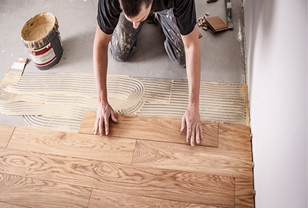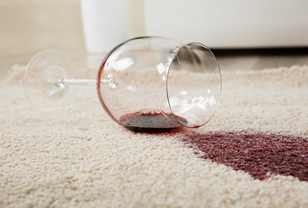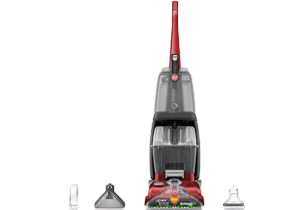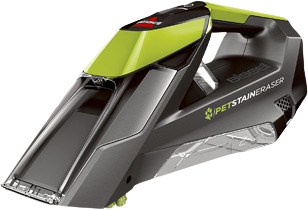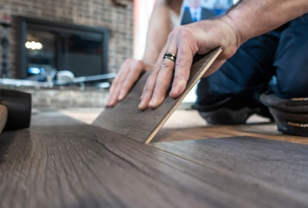How to Clean Bathroom Sink Drain in the Best Way Possible
That is why everyone needs to know how to clean out a bathroom sink drain and this article has got you covered. Cleaning out bathroom sink drains has never been as easy as what you are about to see. For all those who want to know how to clean bathroom sink drains, then you are in the right place.
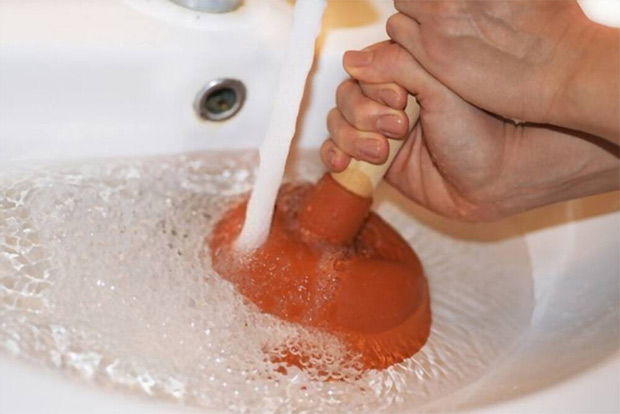
A picture of a woman trying to clean her sink drain
Besides showing you how you can efficiently clean your bathroom, we also have tips for how you can remove those pesky hair clogs. You can clean it with natural ingredients. If you wish, you could also use commercial detergents to get the job done.
It is always uncomfortable to wake up one morning and discover that your sink or shower is blocked. In this situation, it is difficult to think of a solution quickly. This is why we are looking at one of the most frequent causes of a clogged drain in your bathroom today. This format will allow you to identify the cause of the clog very quickly, as well as provide you with simple and effective solutions to restore circulation in your pipes.
➜ RELATED: How to Clean Bathroom for a Healthier Living Environment
1. Hair
When a shower or sink gets clogged, one of the most common causes is due to a lump of hair that got stuck in the drain. In this kind of situation, the hair will form a block that will reduce the flow of water or even plug the drain.
It is true that this kind of clog is not very pleasant when it comes to removing it and you will even be tempted to use the many chemicals that are sold to you as miracle products against hair clumps. Unfortunately, this type of product can become a real danger for your pipes and your health. Over time and over long-term use, these products will irreversibly damage your sewer system. This reaction is due to the chemical composition of these products, which is extremely corrosive.
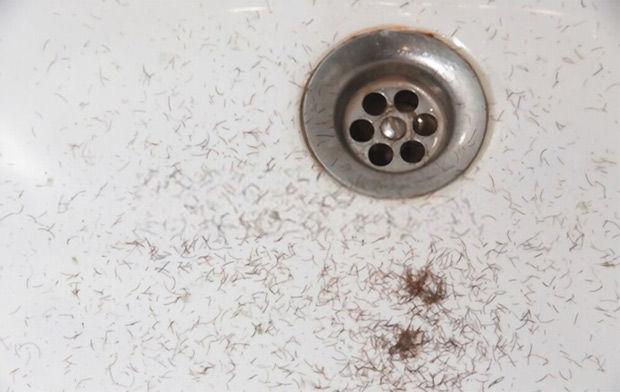
A sink drain with hair making it dirty
To prevent this type of clog from forming, remember to regularly disassemble your drain and remove the hair which can slow the flow of water. Be aware that there are products that prevent hairr from entering the pipe in the first place.
2. Products, Soap and Shower Gel
The second reason is products used for body maintenance and products for pipe maintenance.
The soaps used to cleanse your body can become a real scourge for your showers and sinks if you misuse them. It is important to note that a standard soap regularly leaves deposits in your drain which, over time, cause a clog inside the pipe network. Same principle applies to shower gel, but it behaves differently.
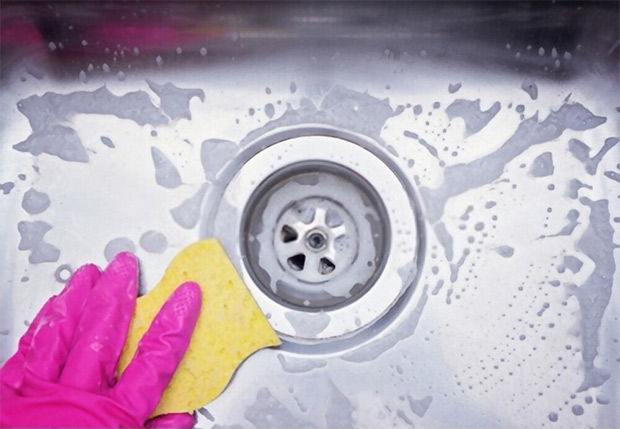
A lady cleaning her bathroom sink drain carefully
Too much use of the latter causes greases to form in your pipes. It is therefore very important, depending on the type of hygienic product you use, to take care to use small amounts to avoid clogging your pipes or pouring in vinegar and baking soda from time to time, the recipe for which you will find in the next article.
In the second step, we have pipeline maintenance products. Many advertisements or even slogans on the thousands of products shout about their effectiveness inside your pipes.
Unfortunately, this type of product is very dangerous for four reasons:
1. Corrosive products
The chemical composition of these products is generally very corrosive, which can seriously damage your sewer system.
2. Products used at the wrong time
Generally, this type of product is used when you have identified a clog inside the pipes. Unfortunately, it is already too late. The product will simply collect lime or soap deposits upstream in your pipe and block them further down. This will simply make your current situation worse.
Mixing certain products together can cause an explosion. Finally, we recommend that you completely ban chemicals harmful to our planet.
3. Vent problem
Vent or primary ventilation issues often generate odors in your showers and sinks. They are due to poor circulation inside your pipes, which comes out directly through your sanitary equipment (toilet, shower, bath, sink) or through your sinks.
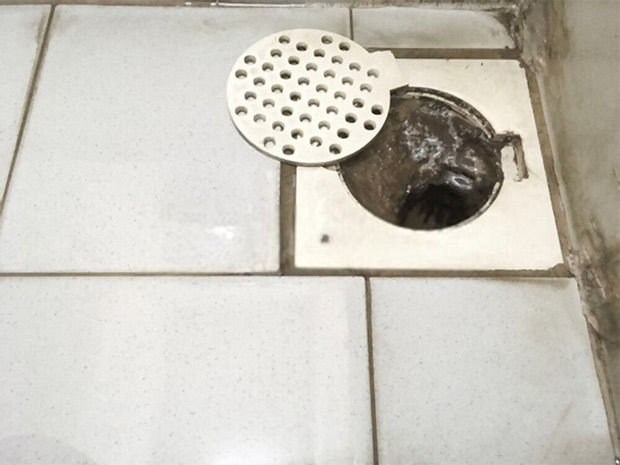
A blocked and dirty opened up bathroom sink drain
Wastewater piping networks must be connected at the periphery (roof or roof of dwellings, or primary ventilation in the lower part under a crawl space) to a vent system that will allow air intake for good flow and evacuation of bad odors.
The vent is a small hatch, usually located on your roof. It vents your pipes and prevents unpleasant odors. It is important to check that your vent is not blocked by tree leaves or other objects regularly (take a look during the maintenance of your gutters).
The vents are always overlooked and it is very important to check them regularly to keep pipes healthy. Read our article about the problems with pipeline odors, and vent problems.
➜ RELATED: TOP 8 Tricks to Cleaning Bathroom With Bleach
4. Tartar and limestone
To finish on this Top 4 list, we have the problems with tartar and limestone. This type of problem generally occurs with old shower installations that have not been maintained in several years.
Limestone is present in the water that drains into your sinks. The more time passes, the more your pipeline concentrates deposits of tartar and limestone which cling to the walls and gradually reduce the trickle of water that circulates inside. Do not hesitate to consult the map of France on the hardness of water to inform yourself of presence of limestone in the water in your region by this link about clogged washing machines.
For this type of problem, it is necessary to call in a sanitation specialist like Allo Unblocking which, using a sewer cleaner truck and a nozzle specially designed for cleaning the pipeline, will restore the original diameter of your network. This type of intervention is expected for a standard house every three to five years.
In conclusion for this Top 5 common reasons for a clogged shower or sink, it is very important to remember that improper use or poor maintenance of your pipes can generate significant costs that are potentially avoidable if you follow our advice. You also need to choose the perfect bathroom sink drain cleaner to your drains.
How to empty a sink
If you want to learn how to clean bathroom sink drains, then you need to know how to empty your sink in the first place. Mainly composed of a drain and a siphon, the drainage system allows the evacuation of wastewater from the sink to the pipe. The parts for draining a sink, basin or hand basin are not compatible with a sink, shower or bathtub.
Waste for sink and basin: principle
The drainage system for washbasins is a set of parts connected and screwed together. Attached to the drain hole at the bottom of the sink, the drain is directly connected to the siphon. It makes it possible to control the flow of water and ensures a good seal on the installation. The drain's cap, the valve, can open or close to fill the tank with water.
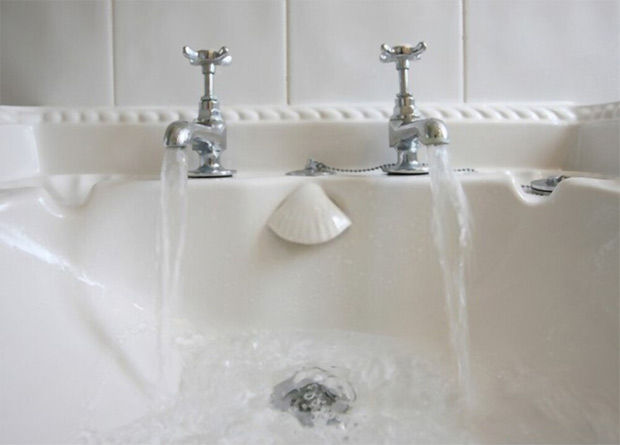
Waste bathroom sink with running water
The top of the drain and the bottom of the drain are screwed to hold the drain against the drain hole. The siphon, screwed under the bung, prevents unwanted odors from rising thanks to a small excess of water and prevents blocked pipes by retaining solid bodies. It is not usually supplied with the drain. Different joints allow for a stable and waterproof installation.
The diameter of the drain hose for sinks, washbasins and hand basins is generally 32 mm, or D32 (or << 1 1/4). The D40 for 40 mm (or << 1 1/2 >>) for sinks, dishwashers, showers and bathtubs. However, universal systems can be connected to both D32 and D40. The drainage systems for sinks and washbasins are easy to install or change.
For sink with or without overflow
The overflow prevents water from overflowing from the sink. You will have to choose your drainage system according to whether your sink has an overflow or not. Except in exceptional cases, the sinks always have an overflow. On the other hand, it happens that basins are not equipped. Washbasins do not usually have an overflow.
To check for the presence of the overflow, look for a small opening at the top of the tank. You will also see a small hole in the drain hole. In fact, the overflow is most often incorporated into the tank: the water flows along an internal hollow wall and is evacuated by the drain, which has a rectangular opening under the valve.
If the sink or basin does not have an overflow, the drain must not have this opening. Prefer a drain with free flow to avoid any risk of overflow. On old installations, it the overflow is not incorporated, but consists of a pipe connected to the drain. The connection will then be more complicated to make, most often on a drain with overflow. Do not hesitate to ask for advice.
Sinks for washbasin or basin: types of plug
With a pull rod (or rod): opening and closing is done by a control generally located at the back of the tap. The installation is more complex but remains accessible for a beginner. And there is no need to plunge your hand into the water to drain the sink! Attention, your tap must be compatible and must, therefore, have a hole at the back in order to let the rod pass.
Bung click-clack / rotary valve: simple pressure on the valve opens or closes the drain.
Stopper: infrequent for sinks and washbasins, the stopper can be a troubleshooting solution.
No closing or free flow: a grid or a valve that is always ajar makes it possible to avoid the small objects going down the drain.
This remains the simplest option in the case of a complex installation: stone basin, custom-made. It is not always easy to find a valve compatible with a plug in place, in case of breakage, for example. You will often have to buy the entire drain, using an identical model or at least the same brand.
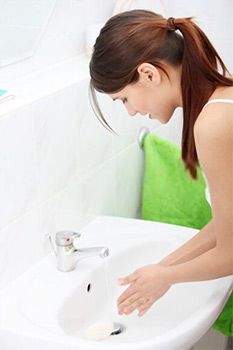
A young and beautiful woman washing her hands in the bathroom
Waste for sink and basin: specific characteristics
Column sink, countertop or built-in basin - Depending on your installation, the drain should have different characteristics.
Standard sink
Most installations are compatible with standard bungs:
- Bathroom sink.
- Vanity top.
- Built-in washbasin.
- Handwashing.
A standard drain has the following characteristics:
- Medium height (about 70 mm).
- With overflow.
- With zipper closure.
- The drain is generally supplied with the tap.
Countertop washbasin
In the case of a countertop basin, the drain must be long enough to cross both the bottom of the tank and the worktop. Do not hesitate to take a few measurements before making your purchase. Please note, the bungs with pull tab are not always suitable for countertop washbasins.
Bowl-shaped washbasin drain
For a bowl-shaped bowl, the drain comes in the form of a long threaded tube, onto which a nut will be screwed. This nut will be screwed on the basin and not on the worktop. It is thus necessary to drill a hole with a hole saw in order to let the bung pass there and to attach the basin to the worktop with silicone.
Siphon and connection: depending on your installation
In addition to avoiding the risk of bad odors, the siphon retains foreign bodies (small objects, hair ...), which ultimately avoids clogging the pipes. Its lower part can be unscrewed for easy maintenance. In contrast, S shaped siphons are more difficult to clean.
Space-saving
Space-saving siphons optimize the space available under the sink or basin, which is very useful, for example, with drawers: either the siphon is offset against the wall, at the back of the cabinet or the siphon is shorter than usual. The body of the drain also functions as a siphon (rare).
How to clean the sink trap
The unpleasant odor that emanates from the sink siphons comes from the accumulation of waste, such as toothpaste and hair. In addition to this debris, mold can develop in the siphon and eventually slow or even obstruct the flow. To avoid clogging, it is necessary to clean it regularly with specific products, such as baking soda and vinegar.
Remove debris from the siphon weekly
To prevent build-up from occurring, you must remove the removable cap or drainage siphon from your sink and dispose of any residue. Rinse them before replacing them.
Most bathroom sinks have an adjustable metal plug that can be used to plug the sink. To remove them, remove them from the siphon.
If the plug works by pressing and pulling a rod behind the tap or is otherwise attached, it is necessary to first remove the nut on the back of the drain hose, then remove the retaining rod and finally the cap to facilitate the process.
Purchase a non-corrosive siphon cleaner, if necessary.
The bathroom sink accumulates bacteria that can contribute to the formation of unwanted odors and deposits in the siphon. Therefore, apply a biodegradable pipe cleaner monthly that does not contain any corrosive substances to eliminate them. Hydrogen peroxide, for example, is an excellent choice and can be poured directly into the siphon.
Some cleaners contain chemicals that are harmful not only to your health, but also to your siphon.
Follow all of the manufacturer's instructions on the label.
Bleach and antibacterial solutions are not effective and can damage the plumbing system. This is even more important if you have a septic tank.
Clean the siphon with homemade products every month
Instead of using chemical compounds to deodorize and clean the sink, mix salt, baking soda, vinegar and lemon juice. Pour the prepared solution into the siphon and wait about an hour before removing the waste with hot water.
➜ RELATED: Lemon Juice for Cleaning: 16 Ways to Use Lemons to Clean Your House
Unclog a bathroom sink
Boil 2 liters of water and pour it gently into the sink
The high water temperature will break down the dirt particles. Thus, the accumulated waste will be eliminated more easily.
Try to purge the siphon with a suction cup
Place the accessory on top of the drain to prevent air from entering and push it up and down about five to six times. In this way, it will be easier to expel the dirt accumulated in the pipe.
Apply baking soda to the siphon
Pour 225 g into the siphon and wait a few minutes. In addition to minimizing unpleasant odors, the compound will unclog the plumbing.
Pour 250 ml of white vinegar into the sink
Do this after applying the baking soda. Then cover the siphon, because the products will seep into it and break the remaining obstruction. The mixture of these two ingredients will create a foam capable of removing all the substances trapped in the plumbing. Then let the compound act for one hour.
In addition to unclogging the pipe of your siphon, the solution will minimize the stench caused by dirt since vinegar is also a natural deodorant.
You can replace white vinegar with apple cider vinegar or lemon juice.
After waiting for the necessary time, rinse the sink with hot water. Repeat the process if necessary.
Remove remaining dirt with a drain snake
It is possible that a resistant deposit requires more effort. Buy a drain snake that you can find at a hardware store. It is an accessory that is made up of long and thin plastic strips provided with hooks on each side which will make it possible to break and push or eliminate the debris that has blocked the siphon more easily.
To use it, simply insert it and rotate the rod in the siphon. Repeat until the strands of hair and other substances have been completely removed. You can bend a metal hanger so that it has a hook at one end and use it as an alternative. When finished, apply the baking soda solution with vinegar to remove unpleasant odors.
Keep your siphon in good condition
Keep garbage away from the sink drain.
Perhaps the most essential part of keeping the siphon clean is knowing what you are putting in it. This is especially the case for the siphon in the bathroom sink, which will inevitably accumulate certain natural detritus, such as locks of hair. However, certain compounds cannot be eliminated directly in the siphons. So, if you have any doubts, throw them out in a conventional way, instead of putting them down the siphon.
Avoid washing dishes or throwing leftover food in the bathroom sink
Throw away hygiene products, such as cotton, dental floss, toilet paper, etc. directly in the trash.
Do not allow small circular plates under the cover of plastic personal care products to come into contact with the siphon.
Use less soap and other products
Residues from certain compounds, often thrown into the bathroom sink, such as soap, toothpaste and shaving cream, can clog the pipes. So get into the habit of using small amounts.
A little toothpaste will be enough to clean your teeth and a little soap will be enough to wash your hands.
Let the tap water run into the siphons for a few seconds after using toothpaste and soap.
Avoid cleaning the siphon with commercial products
There are several reasons why you should not use these kinds of products, which most often contain chemicals. Indeed, in addition to corroding pipes and damaging other components of your home's plumbing system, some of these toxic compounds can pollute water and harm your health.
If your sink drain is often clogged, consider changing the plumbing. Plastic pipes prevent bacteria from growing and don't collect as much dirt. Dispose of drugs, ink residue, and thinners properly. Although they do not damage the pipes, the compounds in question are toxic and can pollute the water.
➜ RELATED: Baking Soda for Cleaning - The Accessible and Effective Household Cleaner
How to always keep a bathroom clean
1. Rinsing
Once you remove all traces of soap from your body, do the same with space around the shower wall. With a sponge, rub each corner of the shower or bathtub and scrape the edges of the walls to remove the soap suds and dirt from the walls and glass spaces.
2. Drain excess water
The best thing to do is to have a squeegee to clean the glass, but above all, remove the water droplets present on the glass spaces or in the wall. This will prevent unwanted stains from settling on the bathroom wall over the long term.
3. Up to the last drop
The quality of the water greatly influences the deterioration of any material in contact. If there is too much limestone in the area where you live, you will have to put in more effort by buying anti-limescale products. It will be necessary to check the knobs as well as the taps more regularly.
4. Spray and Rub
Clean the nooks and crannies of the shower walls as well as each corner of the walls. The joints should be cleaned at least once a week to prevent water from seeping into the walls like soap residue.
5. A bit more
There are many products to spray in the shower after the bath to clean it . Choose the one you like the most and use it every day after your shower. The goal is to facilitate the cleaning of the bathroom while preserving the quality of the bathroom. If you prefer something more natural, white vinegar is perfect.
6. Carefully dry
Always have a microfiber cloth on hand and dry the tap and walls very well so that they always remain shiny, especially after taking a shower. Do not forget to ventilate for at least ten minutes.
7. Goodbye to mold in the bathroom
Regardless of the material your walls are made from, if you spend a minute drying them with a cloth, you will prevent the remnants of soap, organic matter and other dirt to avoid spending several hours cleaning them later.
8. Let the air come into the room
It is very important to leave the bathroom well ventilated after the shower. You will, therefore, help avoid having the humidity cause mold. I also do this for all the rooms in the house.
9. Rub the Soil
If you want to be the master of cleaning, finish cleaning the bathroom by vacuuming the bathroom floor, but also to wash the bathroom floor at least once a week. It only takes a few minutes.
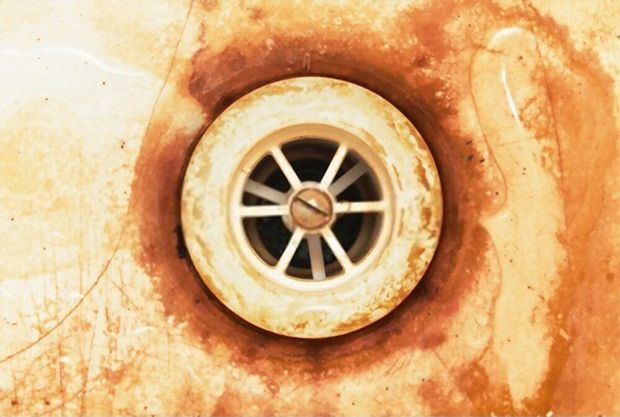
A closeup picture of a dirty and rusty bathroom sink drain
The bathroom is one of the spaces where we waste the most time cleaning: the toilet, the basin or the double basin, the tap, the bath or the shower… Yes, this place is the smallest room in the house, but the one we spend too much time cleaning since this room gets dirty very quickly.
So, these tips for cleaning your bathroom, combined to this foolproof routine, will save you time and take advantage of the clean space every day.
Three Natural Products To Clean The Bathroom
Vinegar, your best friend, is one of the best ways of how to clean bathroom sink drains. As you know, vinegar has a powerful disinfecting effect, neutralizes bad odors, and is also an excellent anti-limescale. Dip the showerhead in a bowl filled with vinegar from time to time to remove the remains that obstruct the water outlets.
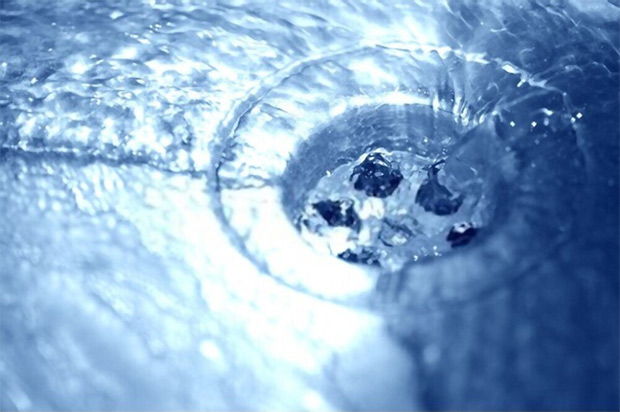
A properly ventilated bathroom sink drain
Hydrogen peroxide versus mold: When mold and the remains of limestone and soap have adhered to your tiles, nothing is better than spraying them with hydrogen peroxide, letting it act for a few minutes and wiping with a clean cloth.
Baking soda for everything: another great ally for effective, chemical-free cleaning. In addition to eliminating odors, a combination of neutral soap and bicarbonate is a very powerful scale inhibitor.
➜ RELATED: How to Clean Tile Floors With Vinegar, Baking Soda, and Lemon?
The 10 health benefits of a bath
Taking a bath is a moment of intense relaxation. But did you know that immersing yourself in water in this way can have a significant impact on our health? Taking a bath is not just a moment of relaxation. For centuries, many doctors have been interested in the healing properties of immersing the body in hot or cold water. And whatever option is chosen, it inevitably brings us its benefits. Here are 10 scientifically proven ones.
Keep the heart-healthy
The heart begins to beat significantly faster upon contact with hot water. It’s a kind of sports session for the organ, which allows for better circulation of blood in the body. In healthy people, hot baths can lower heart pressure and improve heart function.
Breathe better
When the water is very hot and your heart is beating fast, your oxygen supply increases and the water vapor cleans your sinuses and your lungs at the same time. But bathing in cold water can also have beneficial effects on the respiratory system when one is sick.
Immersing yourself in ice water allows people with COPD (Chronic Obstructive Pulmonary Disease), a serious lung syndrome, to significantly reduce the risk of infection.
Reinforce the framework
Moving and exercising in the water has been shown to have a beneficial impact on joints, muscles and bones. Reinforced by the resistance of water, they are thus more solid and reduce the chances of injury in a fall. For people who suffer from osteoarthritis, taking a few movements in the water from time to time would, therefore, reduce the pain.
Calming the nervous system
Immersing yourself in water can reduce the pain of inflammation, but also calm the nervous system by lowering the level of stress felt. Getting hydrotherapy could also help people with sclerosis reduce pain. The last advantage of this care: it brings a certain stability to the condition of Alzheimer's patients as well as a better quality of life.
Improve gastrointestinal health
The heat of a bath can help relieve pain from hemorrhoids and anal fissures. The high temperature helps the sphincter to relax and accelerate the healing of postoperative wounds.
If hot baths are not actually recommended after a good meal, a study has just shown that they could help diabetics to better regulate their weight by increasing the heart rate. Better blood circulation, better digestion.
Facilitate a birth
If giving birth in water is more and more trendy, it is not for nothing. During the first stage of labor, some women choose this option to minimize the pain they experience and relax as much as possible. One way to speed things up when the expectant mother is particularly anxious.
Balance hormone levels
Chronic fatigue and certain hormone-related infertility concerns can be treated with very cold baths. Thanks to the cold temperature, hormones responsible for these troubles, like the corticotrope, balance naturally. If you feel a little depressed, also know that the level of serotonin (the hormone of happiness) increases significantly when taking a hot bath.
Cleanse and moisturize the skin
Immersing yourself in a hot bath or taking a session in a steam bath is a great way to cleanse and moisturize the skin. To strengthen the action of the water, it is recommended to add oil with moisturizing properties and bath salts rich in minerals.
The hot water will also open the pores of the skin and make us sweat. An excellent natural body wash, which eliminates toxins. Conversely, immersing yourself in cold water helps tighten the pores of the skin and reduce sweating, while continuing to hydrate it.
➜ RELATED: 50 Amazing Cleaning Tips You'll Wish You Knew Sooner
Optimizing your body temperature
There is nothing more effective than a bath to regulate your body temperature. Are you hot? Easy, just put yourself in a very cold shower. Are you shivering? Take a hot bath, it's radical.
Strengthen your immune system
Taking a very hot bath helps kill bacteria and strengthens the immune system. In the same vein, hot water has the power to relieve the symptoms of flu or cold. As for immersion in ice water, it has been shown to reduce the risk of necrosis and even increase the life expectancy of people with certain forms of cancer.
Bathroom: Decoration mistakes to avoid
If the bathroom is primarily a place reserved for hygiene, this does not mean that we should not decorate it. On the contrary, the more beautiful our bathroom, the more we will want to spend time there! However, to have a well-decorated bathroom, there are mistakes to avoid at all costs.
A bathroom is a place where you take care of yourself and your body. It is, therefore, a precious place in our daily life. However, many small mistakes in taste, layout and organization can spoil everything. Here is a list of those mistakes.
Too small of a shower
Don't think that because you have a little available that you can set your sights on a tiny shower. Replacing a large bathtub with a shower tray is rather clever. But taking a shower every day in a tooof a small space, where you bump into the walls, can become a real ordeal!
Instead, optimize the space with several techniques. For example, the choice of a walk-in shower can be wise to give an impression of grandeur.
Poor organization of space
Do not place the toilet right in front of the shower outlet, for example. Or, wedge the sink just behind the door, which means that you have to close the door to brush your teeth. These are the little things that make it unpleasant to use.
Instead, think of the space in advance to make the circulation in the bathroom as smooth as possible. For example, consider putting the toilet in an isolated area rather than just in front of the front door. And separate the spaces with half partitions or storage shelves.
A lack of storage space
Do not choose a bathroom that is too clean, where small objects such as soap and toothbrushes find themselves lying on the edge of the sink, while the boxes of medicines are piled up in the tiny and unique piece of furniture. Rather than a clean result, it will be the mess for sure!
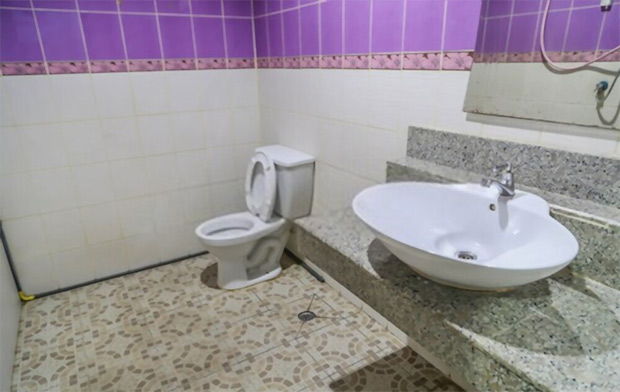
A toilet and a sink in a large spaced area
Favor closed storage spaces, at least partially, which, in addition to better organizing the bathroom, will bring a nice decorative touch! Start by estimating what needs to be placed in the bathroom (towels, sheets, but also brooms and buckets for the laundry space). Shelves, small storage accessories, or large closets, the choice is yours.
A bulky door
You should install a door that opens inward if it blocks access to the sink. Or install a door that opens outwards if it does not pass over the bedroom carpet! A door must be forgotten to be effective.
Improper location of switches
Do not install switches, or electrical outlets in hard to reach places. Imagine wanting to go into the bathroom at night and having to bump into the sink and the shower wall before reaching the switch. A real ordeal! Another mistake is to place switches or electrical outlets too close to water sources.
Lack of ventilation
Don't end up with a windowless bathroom and ventilation system. It's the best way to let moisture settle in, with mold and bad odors.
Too much or too little lighting
Do not light your bathroom with excessively bright neon lights, nor only light it with small dim lights in the corners. The bathroom is a place where you prepare, so you have to find a way to light it up for the most natural effect possible.
A splashing shower or bathtub
Do not leave your shower or bathtub without an effective wall, such as a curtain or door to block water. Even if it can sometimes seem more elegant to leave your shower without a door, having to clean the water that has spattered across the entire bathroom makes the experience very painful!
➜ RELATED: How to Clean With Vinegar - Amazing Remedies and Cleaning Hacks for Homeowners
Summary
To know how to clean a bathroom sink drain is such an easy yet complicated process that needs to be understood quite well. Knowing how to clean a bathroom drain therefore comes in handy when it comes to dealing with the maintenance of your drain. We hope you now have the knowledge to clean your bathroom sink drain.


